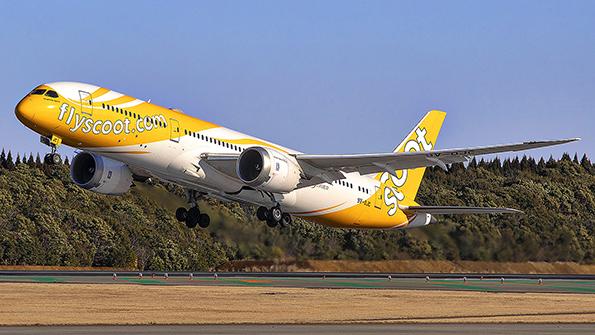
While the long-haul, low-cost business model has gained a foothold in the Asia-Pacific airline market, it has yet to fully prove itself financially. Now some low-cost carriers are betting on this model succeeding in the pandemic recovery phase as they reinstate—and in some cases launch—longer-range widebody flights.
Singapore-based low-cost carrier (LCC) Scoot is leading the way by expanding its European network, and newcomer Zipair Tokyo plans to introduce a route to Los Angeles. Other Asia-Pacific LCCs such as Jetstar and Cebu Pacific are also reactivating widebody aircraft—although not always for long-haul routes. VietJet will be another new player in this segment, and AirAsia X will resume widebody passenger service after gaining a reprieve from creditors.
LCCs are generally expected to have an advantage over full-service carriers in the post-pandemic phase, as leisure travel is likely to rebound faster than premium demand. Narrowbody LCC operations are set to benefit most in this stage due to their reliance on short-haul markets and smaller aircraft with fewer seats to fill.
- Low-cost airlines are activating more of their widebodies
- New operators and routes will be key during the recovery from the pandemic-related downturn
However, widebody LCC services have other factors in their favor. They can reach the markets outside Asia that have been fastest to lift travel restrictions, and widebodies can carry much more cargo as well.
Most of the Asia-Pacific LCCs operating widebodies also have large fleets of narrowbodies, so they have the flexibility to leave their widebodies parked when necessary. Such carriers have tended to return their narrowbody fleets to service more quickly, leaving widebodies inactive for longer. But booming air freight demand has prompted a few LCCs, including Air-Asia X and Scoot, to operate wide-bodies on freight-only flights.
As of the week of Nov. 15, there were about 100 widebody aircraft in LCC fleets in the Northeast Asia, Southeast Asia and Southwest Pacific regions combined, according to the CAPA – Centre for Aviation fleet database. These aircraft are distributed among 11 LCCs: AirAsia X, Beijing Capital Airlines, Cebu Pacific, Citilink, Jetstar, Jin Air, Lion Air, Lucky Air, Scoot, Thai AirAsia X and Zipair Tokyo.
These LCCs initially grounded most of their widebodies when the pandemic hit in early 2020 (see graph). Since then, LCCs have gradually returned more widebodies to service—some in all-freight mode—although by mid-November the number of inactive widebodies was still greater than those in service.
In contrast, LCC operators in the same regions have far more in-service than inactive narrowbody aircraft. As of Nov. 15, there were 947—or about 70%—of LCC narrowbodies in service versus 398 inactive.
The COVID-19 pandemic caused one notable casualty among the Asian long-haul LCCs. Thailand’s NokScoot, which operated Boeing 777s, was closed down in June 2020. However, Zipair has started service since the pandemic began, and VietJet will soon join the ranks of LCC widebody operators.
This means that the Asia-Pacific region will likely come out of the pandemic with at least as many LCCs operating widebodies as before the crisis began, a significant indicator that airlines do not see this model losing its viability.
Looking further ahead, whether long-haul LCCs can thrive depends on the specific business case and the markets being served, notes Darren Hulst, Boeing vice president of commercial marketing. In general, short-haul narrowbody operations have been most successful for LCCs. On longer-range routes, fuel and other costs become a much larger factor, says Hulst. This increases the advantage of having a more diversified product, appealing to a greater range of customers.
Some of the LCCs are offering a more premium option on their widebodies. However, they cannot do this to the same degree as full-service carriers. Another problem is that true long-haul routes hinder the high aircraft utilization rates on which LCCs typically rely. So competing in long-haul markets tends to dilute some of the strengths of the LCC model.
Boosting the case for long-haul LCC service in the current environment is the fact that Europe and the U.S. are reopening to international travel sooner than most countries in the Asia-Pacific region.
In some respects, Asia-Pacific border restrictions mean there are “more opportunities right now for inter-regional travel to restart than intra-regional,” says Subhas Menon, director general of the Association of Asia-Pacific Airlines.
This helps explain why LCCs such as Scoot and Zipair are “looking beyond their region, because that’s where the borders have reopened,” Menon says. “If they have the ability to operate long-haul, and have the aircraft to do so, they . . . may as well go further afield to get things rolling.”
Scoot has reactivated most of the Boeing 787s it uses for medium- and long-haul routes. The carrier, a subsidiary of Singapore Airlines Group, is operating 14 of its 787s on passenger flights, with two being used for cargo flights and another four still parked. It also has 39 Airbus narrowbodies, the majority of which are inactive.
The carrier has restarted its direct flights to Berlin and Athens, Greece, and it has added a leg between Athens and Berlin. In another major move into Europe, Scoot has announced plans to fly from Singapore to London’s Gatwick Airport via Bangkok, beginning Dec. 16.
The 787s are also being operated on routes to Melbourne, Perth and Sydney in Australia, and Hong Kong, Seoul, and Jeddah, Saudi Arabia. However, the widebodies have returned only to a few of the mainland China routes that Scoot operated before the pandemic.
Zipair Tokyo will soon follow Scoot in operating beyond the Asia-Pacific region. The Japan Airlines (JAL) Group launched Zipair as a subsidiary last year, despite the fact that the COVID-19 pandemic had decimated international demand. It began with cargo services in June 2020, before starting its first passenger route in October 2020. The LCC currently serves Bangkok, Seoul, Honolulu and Singapore with 787-8s.
Now Zipair is planning to introduce its first true long-haul route, a service from its base at Tokyo’s Narita Airport to Los Angeles scheduled to begin on Dec. 25. Freight will likely play a large role on this route, as cargo demand has been strong in transpacific markets during the pandemic.
The new route is enabled by the recent arrival of Zipair’s third 787-8, which is leased from JAL. A fourth 787-8 is expected to be added in the spring, which will allow the carrier to look at other market possibilities.
Australia-based LCC Jetstar Airways is preparing to return its 787s to service as the carrier looks to reopen its international network. Six of its 11 787s have been taken out of storage in Alice Springs, Australia, and are either undergoing maintenance or operating ferry and test flights. The remaining five 787s are still in storage, and the airline plans to reactivate them in the coming months. Jetstar has already activated most of its 58 Airbus narrowbodies.
The return of the 787s was accelerated due to significant easing of international travel restrictions in Australia. Jetstar plans to resume flights from Melbourne to Singapore on Dec. 16 and from Sydney to Fiji on Dec. 17. Flights from Sydney and Melbourne to Phuket, Thailand, are scheduled to restart in January and February, respectively.
Jetstar is due to begin taking delivery of Airbus A321LR narrowbodies in the second half of 2022. The carrier intends to use these to replace 787s on some routes to free them up to be used elsewhere.
Philippine LCC Cebu Pacific has returned all of its six Airbus A330s to service, with one being used for all-cargo flights. The carrier uses the other five on domestic routes between key hubs in the Philippines, on short-haul international routes to Hong Kong and Seoul and on one long-haul route to Dubai.
The pandemic has not derailed Cebu’s widebody upgrade program. The carrier has 16 Airbus A330neos on order, with the first expected to enter service in December.
Vietnamese LCC VietJet has been signaling for some time that it is interested in operating widebodies. The fast-growing carrier currently has a fleet of about 75 Airbus narrowbody aircraft, with more than 340 Airbus and Boeing narrowbodies on order.
The airline is taking steps to add A330s. VietJet confirmed on Nov. 5 that it would be receiving three leased A330s before the end of November, which it described as being part of a widebody fleet development plan. It is not clear exactly how the A330s will be used, but VietJet has talked about the ability of these aircraft to enhance its network range.
Malaysia-based AirAsia X was forced to ground its entire fleet of A330s early in the pandemic. The carrier is operating just four of its 22 aircraft now and only for freight services. It plans to activate another two A330s by year-end.
Unlike many other LCCs that operate widebodies, AirAsia X does not have its own narrowbody fleet. It code-shares with short-haul carrier AirAsia, but they are separate companies. This made it particularly vulnerable when international borders were closed.
AirAsia X was at severe risk of being put out of business by the COVID-19 crisis. However, the carrier has gained creditor approval for a drastic financial restructuring that will see most of its debt waived. The debt deal will enable it to reemerge after the pandemic, although it will likely reactivate its passenger services gradually. The carrier has indicated that it will focus on medium-haul rather than true long-haul routes.
AirAsia X has also dramatically curtailed its growth plans after reaching a deal with Airbus to cancel a large proportion of its orders. The airline previously had 78 A330neos and 30 Airbus A321XLRs on order. Under its new arrangement, AirAsia X will retain just 15 of the A330neo orders and 20 of the A321XLRs.
The increasing emergence of long-range narrowbody models will no doubt undermine some of the appeal of widebodies for Asia-Pacific LCCs, and a few such as Jetstar and Air-Asia X have already ordered these new narrowbody types. But there will still be certain markets—long-haul and medium-haul—where widebodies can spell success for LCCs.





